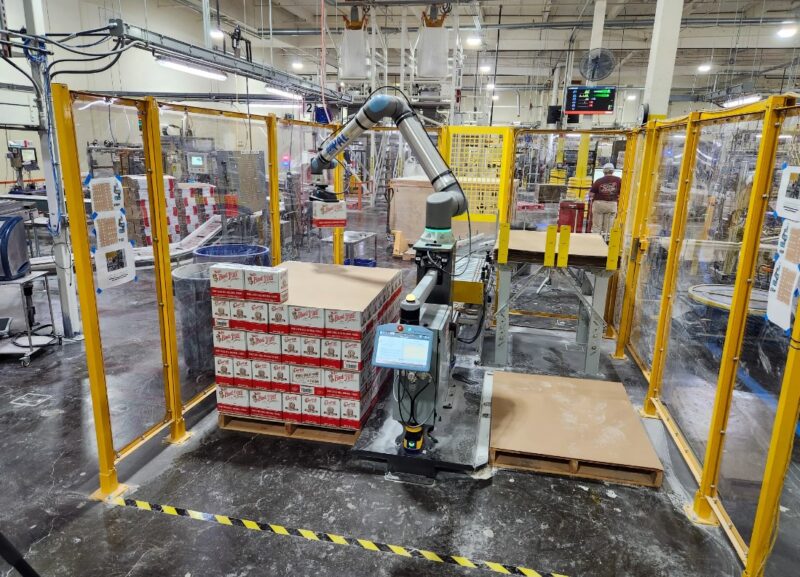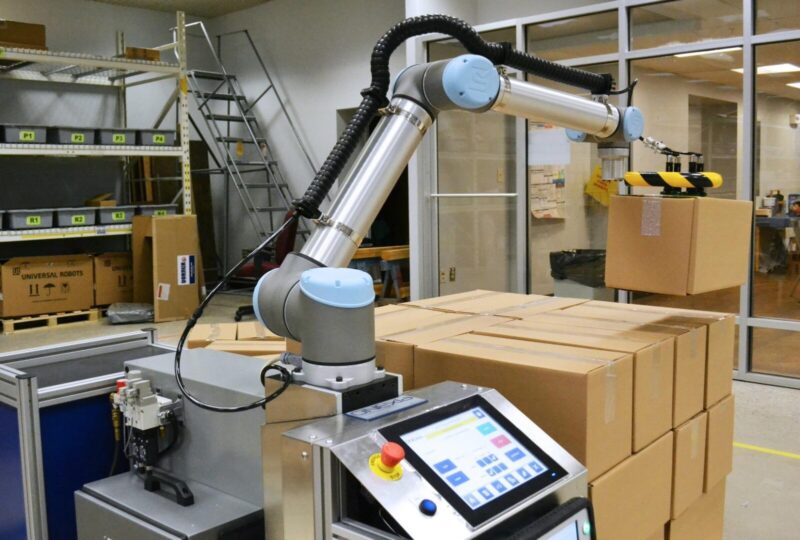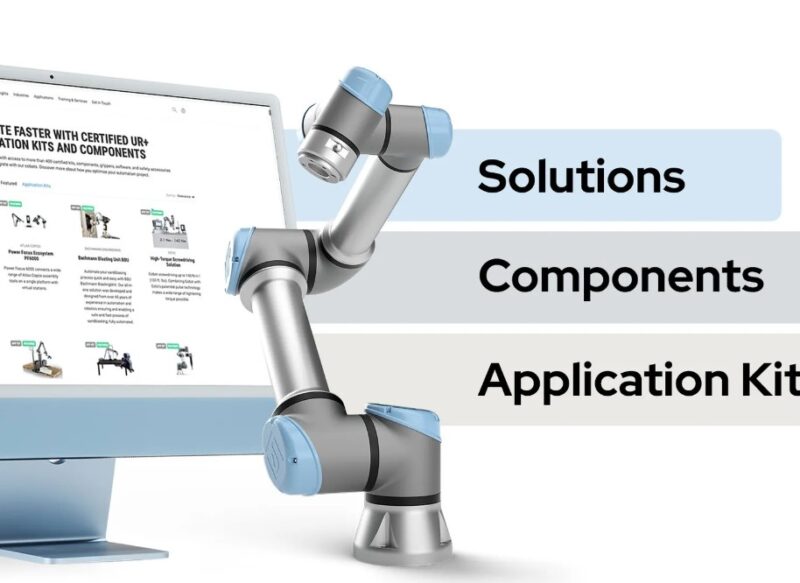In the dynamic world of manufacturing, a silent revolution is taking place. This revolution is driven by the emergence of palletizing cobots – collaborative robots that are redefining the way products are stacked onto pallets.
From automotive assembly lines to food processing facilities, these cobots are reshaping traditional manufacturing processes, bringing forth a new era characterized by efficiency, safety, and adaptability.
At the core of every manufacturing operation lies the palletizing process, where goods are meticulously arranged onto pallets for storage, transportation, or distribution.
Traditionally, this task has been labor-intensive, prone to errors, and constrained by the limitations of conventional robotic systems.
However, with the introduction of palletizing cobots, a paradigm shift has occurred, unlocking new levels of productivity and flexibility in manufacturing.
Understanding Palletizing Cobots

Palletizing cobots represent a departure from conventional industrial palletizing robots. Unlike their predecessors, which often operated in isolation behind safety barriers, cobots are designed to work collaboratively alongside human workers.
Equipped with advanced sensors and intelligent algorithms, these cobots can perceive and adapt to environmental changes, ensuring safe and efficient interaction with human operators.
Compared to manual palletizing or traditional robotic systems, palletizing cobots offer numerous advantages. They can operate continuously without fatigue, significantly increasing productivity and throughput.
Furthermore, their collaborative nature eliminates the need for cumbersome safety measures, fostering a safer and more ergonomic working environment.
Additionally, palletizing cobots are highly versatile and capable of handling a wide range of products and pallet configurations with ease, thereby enhancing operational flexibility.
Technological Advancements
The rise of palletizing cobots is fueled by a convergence of technological advancements. One key innovation lies in the integration of artificial intelligence (AI) and machine learning algorithms into cobot systems.
These algorithms enable cobots to learn from experience and optimize their palletizing strategies over time, leading to further improvements in efficiency and accuracy.
Moreover, advancements in sensor technology and vision systems have enhanced cobots’ ability to perceive and interact with their surroundings. With the aid of sensors and cameras, cobots can precisely identify and manipulate objects, minimizing errors and maximizing efficiency in palletizing tasks.
The Internet of Things (IoT) has also played a pivotal role in the evolution of palletizing cobots. By connecting robots to a network of sensors and devices, manufacturers can monitor and control their operations in real-time, optimizing performance and minimizing downtime.
Additionally, IoT-enabled cobots generate valuable data insights that can be leveraged to improve production processes and drive continuous optimization.
Benefits of Palletizing Cobots

The adoption of palletizing cobots offers a myriad of benefits to manufacturing operations. Firstly, cobots significantly enhance efficiency and productivity by automating repetitive palletizing tasks and operating continuously without breaks. This results in increased throughput and faster turnaround times, ultimately driving greater operational efficiency.
Furthermore, palletizing cobots improves workplace safety by reducing the risk of accidents and injuries associated with manual handling. By collaborating seamlessly with human operators, cobots ensure a safer and more ergonomic working environment, thereby safeguarding the well-being of employees.
Additionally, palletizing cobots offer unparalleled flexibility, allowing manufacturers to adapt quickly to changing production demands. With the ability to handle a wide variety of products and pallet configurations, cobots enable manufacturers to respond swiftly to market fluctuations and customer preferences, ensuring greater agility and competitiveness.
Lastly, palletizing cobots deliver a compelling return on investment (ROI) by reducing labor costs, minimizing errors, and optimizing resource utilization. By streamlining palletizing processes and increasing operational efficiency, cobots enable manufacturers to achieve higher levels of profitability and sustainability.
Challenges and Solutions
Despite their numerous benefits, the widespread adoption of palletizing cobots is challenging. One significant challenge is the potential displacement of human workers.
However, studies have shown that cobots complement rather than replace human labor, creating new opportunities for skilled workers in areas such as programming, maintenance, and supervision.
Technical limitations and integration hurdles also pose challenges to the implementation of palletizing cobots. However, manufacturers can overcome these obstacles through careful planning, robust training programs, and collaboration with experienced cobot integrators.
Moreover, regulatory and ethical considerations surrounding cobot deployment require careful attention to ensure compliance with safety standards and protect workers’ rights.
Future Outlook

The future of palletizing cobots is bright and promising. Market projections indicate robust growth in demand for cobot solutions across various industries, driven by the need for increased productivity, safety, and flexibility.
Furthermore, advancements in cobot technology, such as improved AI algorithms, enhanced sensor capabilities, and more intuitive interfaces, will further accelerate their adoption and integration into manufacturing processes.
As cobots continue to evolve and proliferate, they will undoubtedly reshape the manufacturing landscape, ushering in a new era of automation and efficiency. With their ability to enhance productivity, improve safety, and enable greater flexibility, palletizing cobots are poised to become indispensable assets in the modern manufacturing ecosystem.
Conclusion
In conclusion, the rise of palletizing cobots represents a transformative shift in the manufacturing industry. By leveraging collaboration, technology, and innovation, these cobots are revolutionizing palletizing processes unlocking new levels of efficiency, safety, and adaptability.
As businesses embrace this new era of automation, they stand to reap the benefits of increased productivity, enhanced safety, and greater competitiveness in the global marketplace. Indeed, the rise of palletizing cobots heralds a new chapter in the story of manufacturing – one characterized by innovation, progress, and boundless possibilities.

